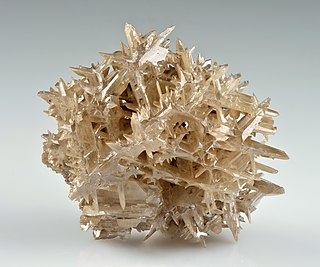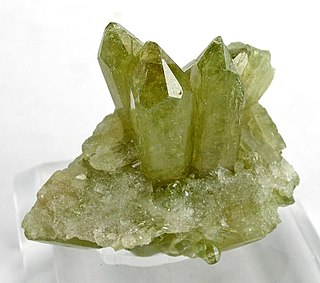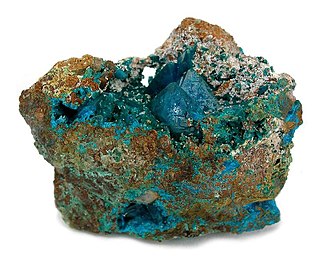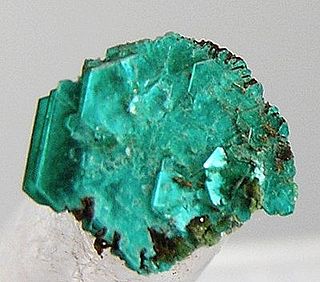
Actinolite is an amphibole silicate mineral with the chemical formula Ca2(Mg4.5–2.5Fe2+0.5–2.5)Si8O22(OH)2.

Bornite, also known as peacock ore, is a sulfide mineral with chemical composition Cu5FeS4 that crystallizes in the orthorhombic system (pseudo-cubic).

Clinoclase is a hydrous copper arsenate mineral, Cu3AsO4(OH)3. Clinoclase is a rare secondary copper mineral and forms acicular crystals in the fractured weathered zone above copper sulfide deposits. It occurs in vitreous, translucent dark blue to dark greenish blue colored crystals and botryoidal masses. The crystal system is monoclinic 2/m. It has a hardness of 2.5–3 and a relative density of 4.3. Associated minerals include malachite, olivenite, quartz, limonite, adamite, azurite, and brochantite among others.

Epidote is a calcium aluminium iron sorosilicate mineral.

Cerussite (also known as lead carbonate or white lead ore) is a mineral consisting of lead carbonate (PbCO3), and is an important ore of lead. The name is from the Latin cerussa, white lead. Cerussa nativa was mentioned by Conrad Gessner in 1565, and in 1832 F. S. Beudant applied the name céruse to the mineral, whilst the present form, cerussite, is due to W. Haidinger (1845). Miners' names in early use were lead-spar and white-lead-ore.

Autunite (hydrated calcium uranyl phosphate), with formula Ca(UO2)2(PO4)2·10–12H2O, is a yellow-greenish fluorescent phosphate mineral with a hardness of 2–2+1⁄2. Autunite crystallizes in the orthorhombic system and often occurs as tabular square crystals, commonly in small crusts or in fan-like masses. Due to the moderate uranium content of 48.27% it is radioactive and also used as uranium ore. Autunite fluoresces bright green to lime green under UV light. The mineral is also called calco-uranite, but this name is rarely used and effectively outdated.

Cuprite is an oxide mineral composed of copper(I) oxide Cu2O, and is a minor ore of copper.

Dioptase is an intense emerald-green to bluish-green copper cyclosilicate mineral. It is transparent to translucent. Its luster is vitreous to sub-adamantine. Its formula is Cu6Si6O18·6H2O (also reported as CuSiO2(OH)2). It has a hardness of 5, the same as tooth enamel. Its specific gravity is 3.28–3.35, and it has two perfect and one very good cleavage directions. Additionally, dioptase is very fragile, and specimens must be handled with great care. It is a trigonal mineral, forming 6-sided crystals that are terminated by rhombohedra.

Vivianite (Fe2+
3(PO
4)
2·8H
2O) is a hydrated iron phosphate mineral found in a number of geological environments. Small amounts of manganese Mn2+, magnesium Mg2+, and calcium Ca2+ may substitute for iron Fe2+ in the structure. Pure vivianite is colorless, but the mineral oxidizes very easily, changing the color, and it is usually found as deep blue to deep bluish green prismatic to flattened crystals.
Vivianite crystals are often found inside fossil shells, such as those of bivalves and gastropods, or attached to fossil bone.

Adamite is a zinc arsenate hydroxide mineral, Zn2AsO4OH. It is a mineral that typically occurs in the oxidized or weathered zone above zinc ore occurrences. Pure adamite is colorless, but usually it possess yellow color due to Fe compounds admixture. Tints of green also occur and are connected with copper substitutions in the mineral structure. Olivenite is a copper arsenate that is isostructural with adamite and there is considerable substitution between zinc and copper resulting in an intermediate called cuproadamite. Zincolivenite is a recently discovered mineral being an intermediate mineral with formula CuZn(AsO4)(OH). Manganese, cobalt, and nickel also substitute in the structure. An analogous zinc phosphate, tarbuttite, is known.

Vesuvianite, also known as idocrase, is a green, brown, yellow, or blue silicate mineral. Vesuvianite occurs as tetragonal crystals in skarn deposits and limestones that have been subjected to contact metamorphism. It was first discovered within included blocks or adjacent to lavas on Mount Vesuvius, hence its name. Attractive-looking crystals are sometimes cut as gemstones. Localities which have yielded fine crystallized specimens include Mount Vesuvius and the Ala Valley near Turin, Piedmont.

Liroconite is a complex mineral: Hydrated copper aluminium arsenate hydroxide, with the formula Cu2Al[(OH)4|AsO4]·4(H2O). It is a vitreous monoclinic mineral, colored bright blue to green, often associated with malachite, azurite, olivenite, and clinoclase. It is quite soft, with a Mohs hardness of 2 - 2.5, and has a specific gravity of 2.9 - 3.0.

Descloizite is a rare mineral species consisting of basic lead and zinc vanadate, (Pb, Zn)2(OH)VO4, crystallizing in the orthorhombic crystal system and isomorphous with olivenite. Appreciable gallium and germanium may also be incorporated into the crystal structure.

Shattuckite is a copper silicate hydroxide mineral with formula Cu5(SiO3)4(OH)2. It crystallizes in the orthorhombic – dipyramidal crystal system and usually occurs in a granular massive form and also as fibrous acicular crystals. It is closely allied to plancheite in structure and appearance.

Chalcophyllite is a rare secondary copper arsenate mineral occurring in the oxidized zones of some arsenic-bearing copper deposits. It was first described from material collected in Germany. At one time chalcophyllite from Wheal Tamar in Cornwall, England, was called tamarite, but this name is now discredited. At Wheal Gorland a specimen exhibiting partial replacement of liriconite, Cu
2Al(AsO
4)(OH)
4•(4H
2O), by chalcophyllite has been found. The mineral is named from the Greek, chalco "copper" and fyllon, "leaf", in allusion to its composition and platy structure. It is a classic Cornish mineral that can be confused with tabular spangolite.

Conichalcite, CaCu(AsO4)(OH), is a relatively common arsenate mineral related to duftite (PbCu(AsO4)(OH)). It is green, often botryoidal, and occurs in the oxidation zone of some metal deposits. It occurs with limonite, malachite, beudantite, adamite, cuproadamite, olivenite and smithsonite.

Cornubite is a rare secondary copper arsenate mineral with formula: Cu5(AsO4)2(OH)4. It was first described for its discovery in 1958 in Wheal Carpenter, Gwinear, Cornwall, England, UK. The name is from Cornubia, the medieval Latin name for Cornwall. It is a dimorph of cornwallite, and the arsenic analogue of pseudomalachite.

Langite is a rare hydrated copper sulfate mineral, with hydroxyl, found almost exclusively in druses of small crystals. It is formed from the oxidation of copper sulfides, and was first described in specimens from Cornwall, United Kingdom. It is dimorphous with wroewolfeite. Langite was discovered in 1864 and named after the physicist and crystallographer Viktor von Lang (1838–1921), who was Professor of Physics at the University of Vienna, Austria.

Tsumebite is a rare phosphate mineral named in 1912 after the locality where it was first found, the Tsumeb mine in Namibia, well known to mineral collectors for the wide range of minerals found there. Tsumebite is a compound phosphate and sulfate of lead and copper, with hydroxyl, formula Pb2Cu(PO4)(SO4)(OH). There is a similar mineral called arsentsumebite, where the phosphate group PO4 is replaced by the arsenate group AsO4, giving the formula Pb2Cu(AsO4)(SO4)(OH). Both minerals are members of the brackebuschite group.

Cornwallite is an uncommon copper arsenate mineral with formula Cu5(AsO4)2(OH)4. It forms a series with the phosphate pseudomalachite and is a dimorph of the triclinic cornubite. It is a green monoclinic mineral which forms as radial to fibrous encrustations.





















